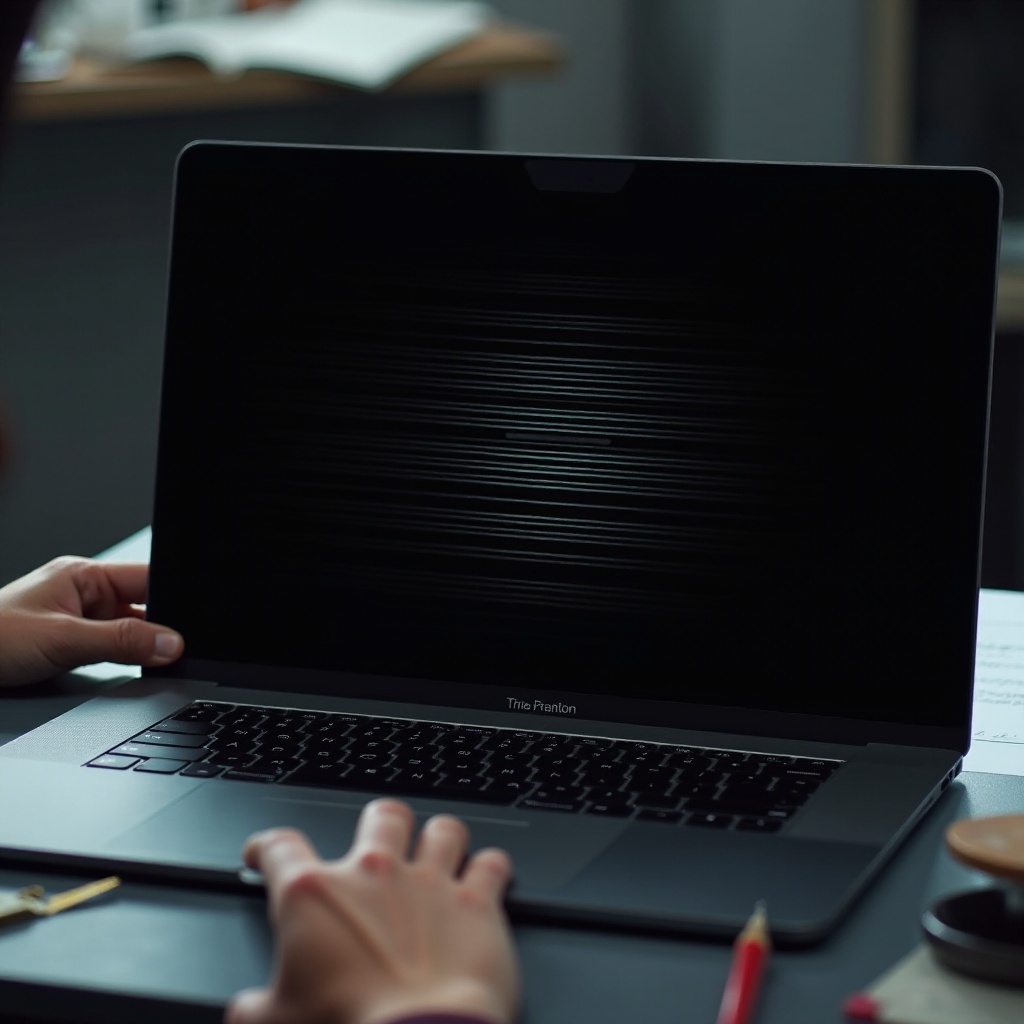Introduction
Seeing your laptop screen turn black with lines can be alarming. It's often the first sign of a problem that can range from simple to severe. Thankfully, you can address most of these issues with some understanding and a few straightforward steps. This guide will help you diagnose the problem, attempt quick fixes, and understand when it's best to seek professional help.

Common Causes of a Black Laptop Screen with Lines
Various factors could cause your laptop screen to display black with lines. Understanding these reasons is the first step in resolving the problem.
Hardware Issues
- Faulty Display Cable: The ribbon cable connecting the screen to the motherboard might be loose or damaged.
- Damaged Screen: Physical damage to the screen can result in black spots and lines.
- Malfunctioning GPU: The Graphics Processing Unit (GPU) may be the culprit, particularly if it's overheating or failing.
Software Problems
- Driver Issues: Graphics driver issues can cause display problems. An incompatible or outdated driver can lead to screen failures.
- Operating System Errors: OS issues can sometimes manifest as display problems, including black screens and lines.
Environmental Factors
- Physical Damage: Drops or pressure on the screen can lead to cracks and malfunction.
- Extreme Temperature Changes: Rapid temperature variations can affect the internal components, leading to display issues.
With these causes in mind, the next step is to perform some initial checks and quick fixes that might resolve the problem.
Quick Fixes You Can Try First
Before diving into deeper diagnostics, it’s worth trying some simple solutions.
Reboot Your Laptop
Sometimes, a simple restart can resolve the problem. Completely shut down your laptop, wait for a moment, then turn it back on.
Performing a Hard Reset
If rebooting doesn't help, a hard reset might.1. Turn off your laptop.2. Disconnect all external devices.3. Remove the battery (if possible).4. Hold the power button down for 30 seconds, then reconnect the battery and power it up.
Checking for External Connections
Ensure that no external devices or connections are causing the issue. Disconnect all peripherals and try running the laptop on its own display.
If these quick fixes don’t work, it’s time to move on to more in-depth solutions.
In-Depth Solutions
Hardware Solutions
If initial fixes don’t resolve the issue, delve deeper into hardware diagnostics.
Checking Physical Connections
- Display Cable: Ensure the ribbon cable connecting the screen to the motherboard is secure. This may require partial disassembly of the laptop.
- Screen: Check for cracks, discoloration, or other apparent damages.
Repairing or Replacing the Screen
If you find visible damage or the quick fixes do not resolve the issue, you may need to replace the screen. Consult your laptop’s manual for instructions or seek professional repair services.
Testing and Replacing the Graphics Card
If the screen appears to be in good condition, the issue might lie with the GPU. Connect your laptop to an external monitor:1. If the external display works fine, the issue is likely with your screen or connection cable.2. If the external monitor also shows issues, you might need to replace your GPU.
Software Solutions
If hardware checks do not reveal issues, your problem might be software-related.
Updating Graphics Drivers
Ensuring your graphics drivers are up-to-date can resolve many display issues.1. Go to Device Manager.2. Find Display adapters.3. Right-click on your graphics card and select Update driver.
Rolling Back Windows Updates
Sometimes, a recent update can cause display issues. Rollback the last update:1. Go to Settings.2. Select Update & Security.3. Choose Windows Update, then View update history and Uninstall updates.
Performing a Clean Boot
A clean boot starts Windows with a minimal set of drivers and startup programs.1. Type msconfig in the search box and press Enter.2. Under the General tab, select Selective startup.3. Clear Load startup items check box.4. Go to the Services tab, select Hide all Microsoft services, and click Disable all.
Advanced Troubleshooting
If software solutions don’t work, try these advanced troubleshooting steps.
Analyzing Logs and Event Viewer
Use Event Viewer to check for errors:1. Press Win + X and select Event Viewer.2. Look under Windows Logs > System to find any critical errors.
Using a Second Monitor for Cross-verification
To be sure that the issue is with your laptop display:1. Connect your laptop to an external monitor.2. If the external monitor works fine, you’ve isolated the issue to your laptop’s display hardware or connections.
If these solutions fail to resolve the problem, it might be time to seek help from an expert.

When to Seek Professional Help
Recognizing the Need for Expert Intervention
If you’ve tried all the above solutions and the screen is still black with lines, professional help may be necessary.
How to Choose a Reliable Repair Service
Look for a reputable repair service with:1. Good reviews.2. Certified technicians.3. Transparent pricing.
Expectations During Professional Repair
Be prepared for:1. Diagnosis fees.2. Potential hardware replacements.3. Estimated timelines for repair completion.
Preventive Measures and Tips to Avoid Future Screen Issues
Taking care of your laptop can help prevent screen issues.
Regular Maintenance and Cleaning
- Dust and clean your laptop regularly.
- Ensure proper ventilation to avoid overheating.
Updating Drivers and OS Regularly
Keep your drivers and operating system up-to-date to prevent compatibility issues.
Proper Handling and Storage
Avoid dropping your laptop and protect it from physical damage. Store it in a cool, dry place to avoid moisture and temperature extremes.

Conclusion
A black screen with lines on your laptop can be daunting, but with these steps, you can diagnose and often fix the problem yourself. Remember, if the issue persists despite your efforts, professional help is the best course.
Frequently Asked Questions
Why is my laptop screen black with lines all of a sudden?
It could be due to hardware issues like a damaged screen or loose cables, or software problems like outdated drivers.
Can a black screen with lines be fixed at home?
Yes, many issues can be resolved with basic troubleshooting steps and updates, but some hardware problems may require professional repair.
How much does it cost to repair a laptop screen with these issues?
Repair costs can vary greatly depending on the issue, ranging from $50 for minor fixes to over $300 for significant hardware replacements.
